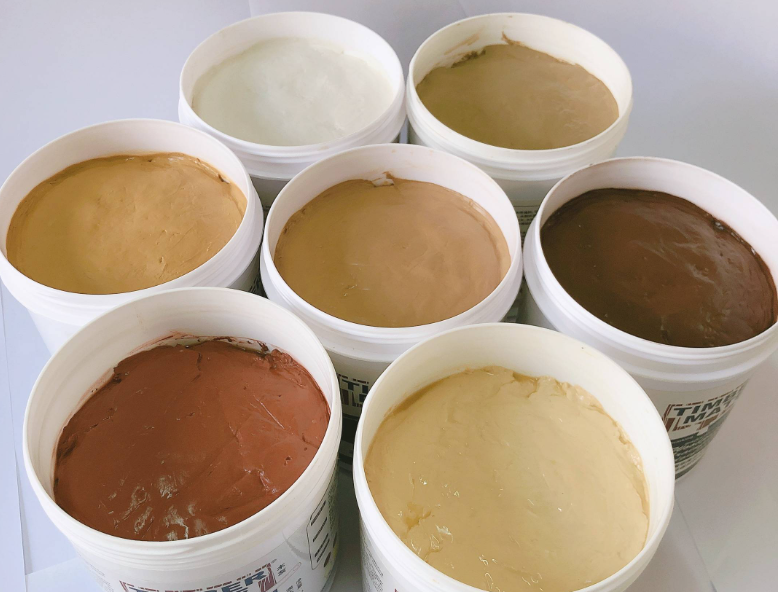光固化竹木涂料
在当今材料科学与工业应用的璀璨星空中,光固化涂料犹如一颗耀眼的明星,正以其独特的魅力闪耀在众多领域。光固化涂料之所以能够赢得广泛青睐,根本原因在于它集快速干燥固化、环保节能等诸多优点于一身,俨然是一个全能选手,迅速在各行各业中崭露头角。
回顾历史,光固化涂料的发展脉络清晰。早年,它主要是在木器涂料领域大展拳脚,为木制品披上一层保护与装饰兼具的 "外衣"。而近二十年的时间,可谓是光固化涂料发展的黄金时期。随着科研人员在高效光引发剂、活性稀释剂和低聚物等关键领域的不断攻关,一系列突破性成果如雨后春笋般涌现。与此同时,敏锐洞察市场需求的企业和研发团队精准发力,推动紫外光固化技术拓展边界,其应用版图得以稳步扩大。
目前,光固化涂料家族方兴未艾,涵盖了光固化竹木涂料、纸张涂料、塑料涂料等多个门类,广泛渗透到我们生活生产的方方面面。从日常生活中的竹木地板、家具,到工业制造中的金属零件、电子元件,再到汽车领域的车身涂装,甚至装饰领域的织物印染,都有光固化涂料忙碌的身影。不仅如此,其外观风格也发生了华丽的转变,从最初单一的高光型,一路发展到哑光型、磨砂型、金属闪光型等多样化风格,以满足人们日益多样化的审美需求。涂装方式更是百花齐放,辊涂、刮涂、喷涂......各显神通,适应不同的场景和基材。
专注于光固化竹木涂料,是光固化涂料阵营中的 "排头兵",不仅产量可观,而且率先开启了产业化征程。追溯到 20 世纪 60 年代初,德国拜耳公司率先成功研制出第一代光固化涂料--光固化竹木涂料,为行业发展立下了汗马功劳。这类涂料优势显著,涂装性能突出,固化速度快如闪电,在设备应用上稳如泰山,加工成本亲民,更关键的是有机挥发物排放量极低甚至为零,非常适合环保趋势。
在竹木产品的应用中,光固化竹木涂料大显身手,主要集中在浸涂、填充和罩印三个关键环节。根据使用场景和质量要求,又细分为实木复合地板涂料、单板涂料以及清漆、色漆等类别。在涂装方式上,以辊涂为主,辅以喷涂、滴涂等多样化方式。
深入探究光固化竹木涂料品类,各有千秋。先说 UV 竹木腻子涂料,它就像一位 "美容师",专门为表面粗糙的木材 "整容"。像刨花板、纤维板这样平整度较差的木材,在它的精心雕琢下,细小的孔洞和微小的缺陷都被一一填补,基材表面得以密封,后续涂刷的装饰涂料就能均匀附着,打造出光滑平整的外观。这种腻子涂料本质上是一种膏状物,成分丰富,除了常规的 "类 "光固化涂料--光引发剂、低聚物、活性稀释剂外,还加入了大量的无机填料。填料的选择可是个精细活儿,不仅要保证对固化速度的影响小,还要具有低折射率、易打磨等优良特性。滑石粉、碳酸钙等一大批无机填料纷纷登场,各显神通。不饱和聚酯体系的 UV 腻子涂料性价比高,价格实惠;丙烯酸体系的树脂和单体就像催化剂,大大提高了固化速度,使涂层外观薄而不失丰满。

UV 固化腻子参考配方
UV 竹材底漆和 UV 粘合剂各司其职。UV 粘合剂侧重于粗糙的木材,而 UV 底漆则侧重于相对光滑平整的木材。它含有较少的无机填料,粘度较低,类似于 UV 面漆。当一层 UV 底漆轻轻覆盖在木材表面时,低粘度使它像一个灵活的小精灵,悄无声息地渗入木材的细小孔隙,借助薄膜的折射作用,巧妙地保留并增强了木材纹理和孔隙结构的自然美感。UV 光固化后,砂纸打磨、UV 面漆覆盖固化等工序一气呵成,最终呈现出平整、光滑、饱满的完美效果。值得一提的是,UV底漆中的无机腻子与UV腻子涂料中的同类产品,虽然作用相似,却在细微之处有所区别,共同为涂层的牢固 "保驾护航"。打磨工序同样不可或缺。它就像一个纽带,可以加强涂层之间的附着力,使面漆稳定附着,消除脱落风险。此外,还可以使用少量硬脂酸锌来润滑打磨过程,防止打磨过程中出现 "白雾"。不过,无机填料的使用必须谨慎,因为许多硬脂酸金属盐的消光效果较弱,折射率较高的填料可能会干扰固化性能,这一点必须加以考虑。
UV 固化腻子参考配方
| 光引发剂 ITX | 1% |
| 2 二甲基胺苯甲酸乙酯 | 4.8% |
| 双酚 A 环氧丙烯酸酯 | 28.22% |
| TMPMA | 7.53% |
| nvp | 1.88% |
| 表面活性剂 | 0.13% |
| 二氧化钛 | 14.11% |
| 滑石粉 | 14.11% |
| 氧化钡 | 28.22% |
最后,UV 竹节面漆的独特之处在于它不含无机填料,纯粹是为了在天然木材或木质饰面上形成高光封闭纹理面漆而配制的。要获得哑光或磨砂效果,适量的二氧化硅消光剂是关键 "密码"。各类丙烯酸涂料可以根据需要进行混合,无论是高光或哑光、有色或无色,还是不同的涂装方法和应用场景,都能精确地进行调整。要配制出理想的哑光 UV 面漆并非易事,粒径为 25 μm 的 SiO2 通常被用作消光剂。此外,组合加工技术为光泽控制带来了新的可能性。电子束固化和紫外线固化携手合作,可使涂层表面出现极细的皱纹,出现哑光效果;不同类型的紫外线光源双重固化,低压紫外线灯预热,再用高压汞灯强化,同样可以创造出低光泽质感,为光固化涂料的艺术表现力增色不少。
展望未来,随着光固化技术的不断迭代升级,光固化涂层有望突破更多界限,或许会在智能材料、生物医学等前沿领域开辟出一条全新的赛道。试想,光固化涂层可以根据环境变化智能调节性能,或者作为生物相容性材料帮助人体组织修复,这些看似遥不可及的愿景,或许在不久的将来就能成为现实,让我们拭目以待光固化涂层更加辉煌的明天。
立即联系我们!
如果您需要价格,请在下表中填写您的联系信息,我们通常会在 24 小时内与您联系。您也可以给我发电子邮件 info@longchangchemical.com 请在工作时间(UTC+8 周一至周六,上午 8:30 至下午 6:00)或使用网站即时聊天工具获得及时回复。
| 光引发剂 TPO | 化学文摘社编号 75980-60-8 |
| 光引发剂 TMO | cas 270586-78-2 |
| 光引发剂 PD-01 | 化学文摘社编号 579-07-7 |
| 光引发剂 PBZ | 化学文摘社编号 2128-93-0 |
| 光引发剂 OXE-02 | cas 478556-66-0 |
| 光引发剂 OMBB | 化学文摘社 606-28-0 |
| 光引发剂 MPBZ (6012) | CAS 86428-83-3 |
| 光引发剂 MBP | 化学文摘社编号 134-84-9 |
| 光引发剂 MBF | 化学文摘社编号 15206-55-0 |
| 光引发剂 LAP | 化学文摘社编号 85073-19-4 |
| 光引发剂 ITX | CAS 5495-84-1 |
| 光引发剂 EMK | 化学文摘社编号 90-93-7 |
| 光引发剂 EHA | 化学文摘社编号 21245-02-3 |
| 光引发剂 EDB | CAS 10287-53-3 |
| 光引发剂 DETX | 化学文摘社编号 82799-44-8 |
| 光引发剂 CQ / 樟脑醌 | 化学文摘社编号 10373-78-1 |
| 光引发剂 CBP | 化学文摘社编号 134-85-0 |
| 光引发剂 BP / 二苯甲酮 | 化学文摘社编号 119-61-9 |
| 光引发剂 BMS | 化学文摘社 83846-85-9 |
| 光引发剂 938 | 化学文摘社编号 61358-25-6 |
| 光引发剂 937 | CAS 71786-70-4 |
| 光引发剂 819 DW | cas 162881-26-7 |
| 光引发剂 819 | cas 162881-26-7 |
| 光引发剂 784 | cas 125051-32-3 |
| 光引发剂 754 | CAS 211510-16-6 442536-99-4 |
| 光引发剂 6993 | 化学文摘社编号 71449-78-0 |
| 光引发剂 6976 | cas 71449-78-0 89452-37-9 108-32-7 |
| 光引发剂 379 | cas 119344-86-4 |
| 光引发剂 369 | cas 119313-12-1 |
| 光引发剂 160 | 化学文摘社编号 71868-15-0 |
| 光引发剂 1206 | |
| 光引发剂 1173 | 化学文摘社编号 7473-98-5 |
